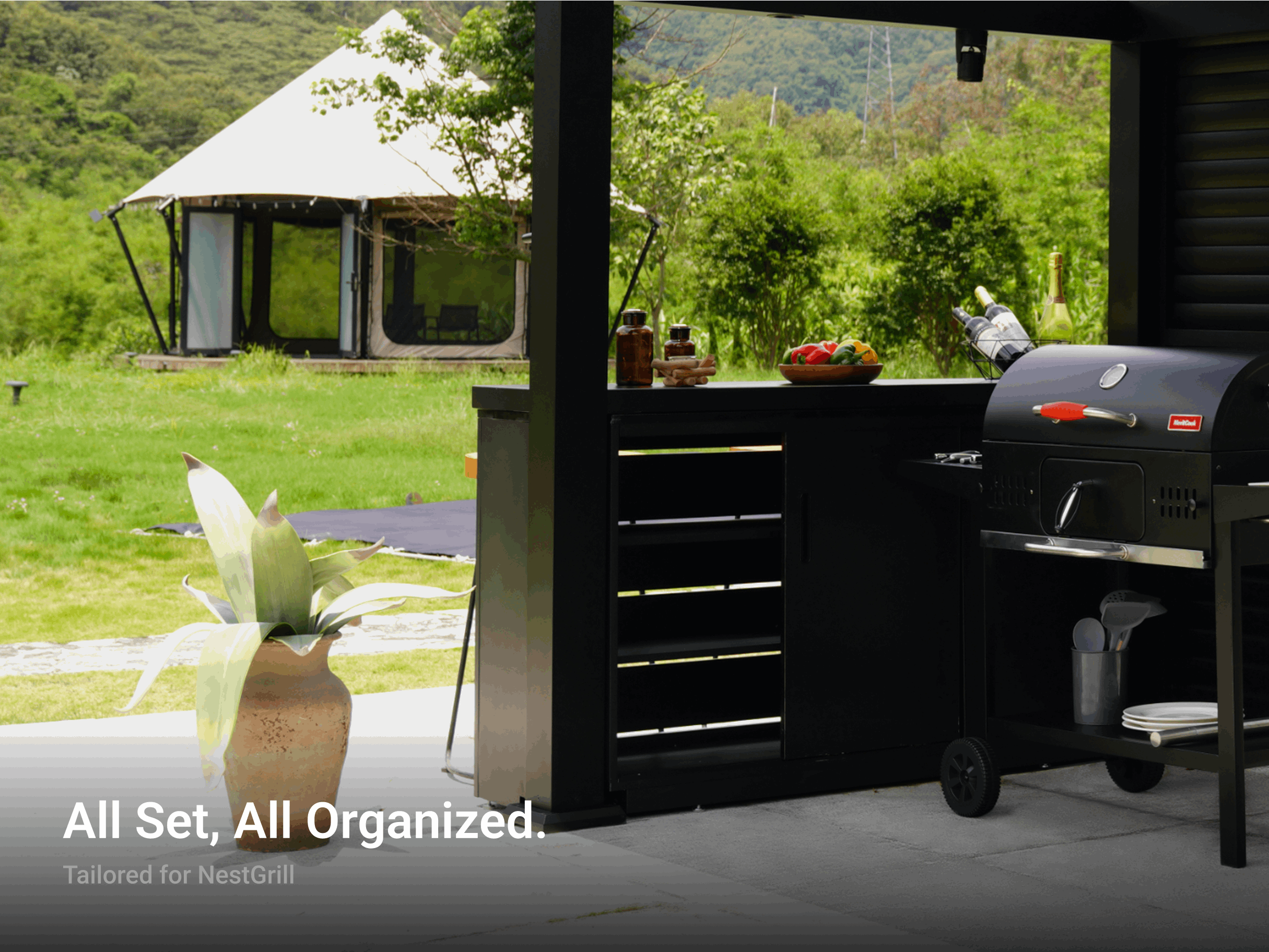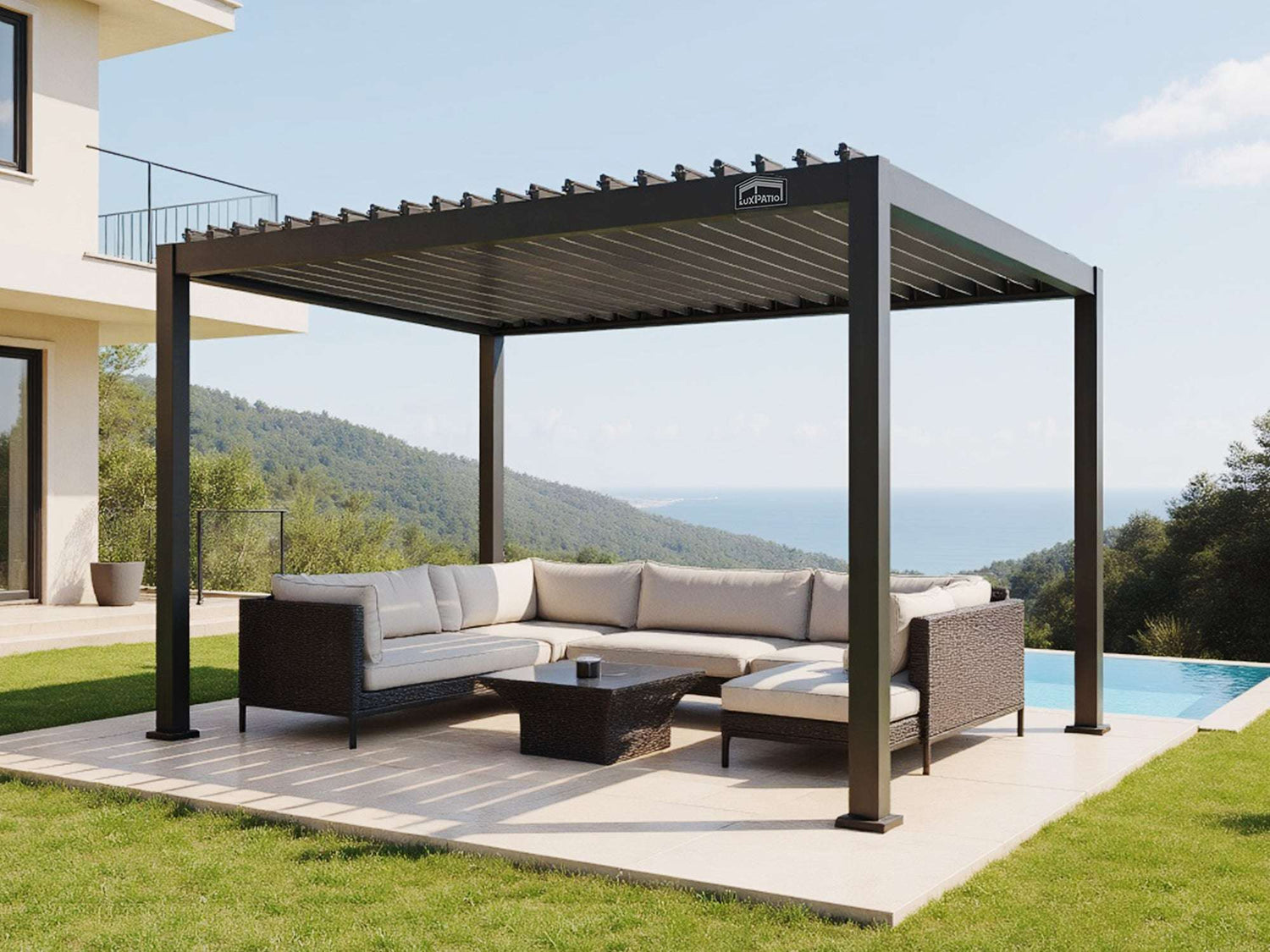Cold air, wind, and lingering moisture expose weak spots in any outdoor setup. Water settles into hairline gaps and expands when temperatures swing. Salt and grit stress coatings and hardware. A clear plan for patio maintenance preserves finishes, keeps cushions dry, and turns spring reopening into a simple rinse and reset. The tips below stay practical, friendly, and easy to repeat.

Tip 1: Pre-Winter Preparation for Patio Maintenance
Slow down for a minute. Walk the space, take a few photos, and note where water pools, where shade lingers, and which joints feel loose. Group tasks into three buckets: clean, reinforce, then cover or store. Pick a dry afternoon with mild sun, and you will move faster and feel less rushed. This quick baseline anchors your winter patio care plan.
Tools and Supplies
- Soft brush, nonabrasive sponge, microfiber cloths
- Mild pH-neutral cleaner and warm water
- Plastic scraper for sap and bird droppings
- Touch-up paint or clear coat that matches your finish
- Light lubricant for hinges and moving parts
- Fitted covers that breathe, with vents and tie-downs
- Bins or breathable bags for cushions, plus moisture absorbers
Steps
- Rinse, then wash all surfaces. Clear seams, slats, and feet. Rinse again and let everything truly dry.
- Tighten hardware. Mark chips and scuffs for same-day touch-up while the weather cooperates.
- Open storage benches and tables, dry the interior, and add small spacers if condensation tends to form.
- Clean cushions and sling fabrics on a day that allows full outdoor drying.
- If puddles are common, raise table feet slightly with pads.
- Snap quick “after” photos. They make the spring setup almost automatic.
Tip 2: Clean Smart Before Temperatures Drop
Grime locks in moisture, and winter magnifies that damage. Wash frames, tops, and weave with mild soap and water, then rinse until runoff turns clear. Avoid high-pressure washing on wood, natural wicker, and aging coatings because roughened fibers hold water deeper. For stone and tile, stick to low pressure and clean water so contaminants are not pushed into pores.
Practical Cues
- Work in open shade so cleaners do not flash dry.
- Use soft bristles with steady, light pressure and follow the grain or weave.
- Finish with a clean-water rinse to reduce residue and slow soil buildup.
Tip 3: Seal and Touch Up High-Risk Zones
Cleaning and drying set the stage. Night-and-day temperature swings enlarge hairline flaws, letting water in and making it slow to escape. While surfaces are warm and dry to the touch, treat the weak spots first so the season starts in your favor.
Powder-Coated Metal
Scan welds, edges, and contact points. Wipe clean, allow to dry, then apply a compatible touch-up. On fully cured coatings, a thin, nonabrasive protective wax can add a sacrificial layer in coastal or roadside settings.
Wood End Grain
Cut ends and undersides to wick moisture. If you prefer color retention, apply a breathable water-based sealer during a dry window. Keep coats thin so vapor can move out.
Fasteners and Hinges
Add a drop of light lubricant, cycle the part, and wipe away excess so dust will not stick.
Tip 4: Wood and Wicker Care That Avoids Moisture Traps
Hardwoods dislike long, damp spells. Natural wicker dislikes soaking and pressure. Resin wicker tolerates moisture better but still hides grit. Your job is simple: move water and dirt out, then give end grain, weave seams, and feet a clear path to dry.
Solid Wood (Teak, Acacia, Eucalyptus)
Use a soft brush and mild solution with strokes that follow the grain, including hidden rails and undersides. Remove resin and bird droppings with a plastic scraper and warm, soapy water. Let boards and end grain dry thoroughly. If a natural silver patina fits your look, keep it clean and skip heavy oils in winter. If you want color retention, choose a breathable sealer and apply lightly where water lingers most.
Natural Wicker (Rattan and Similar Fibers)
Indoors is ideal: dry air with some ventilation. If outdoor storage is unavoidable, elevate feet above wet ground, use a vented cover, and set a quick monthly check for condensation or stressed bindings.
Resin Wicker
Brush debris from the weave, rinse gently, and inspect the underside rails and feet where sand piles up. Let the weave dry fully before covering, so moisture does not sit inside.
Quick Reference
| Material | Key Winter Risk | Best Move Now |
| Teak, Acacia | Moisture at end grain | Clean, dry, thin water-based sealer option |
| Natural Wicker | Swelling and mildew | Indoor storage or vented cover |
| Resin Wicker | Abrasion under covers | Clean weave, dry fully, then cover |
A small line on your family calendar to winterize outdoor furniture each fall keeps this routine on schedule.
Tip 5: Metal and HDPE/Poly Methods That Survive Salt and Slush
Salt spray, de-icers, and fertilizer overspray cause most winter staining and early corrosion. A rinse after storms, quick touch-ups, and a mid-season snug-up keep things steady. The goal is clean surfaces and dry contact points so rust never gains a foothold.
Aluminum with Powder Coat
Repair small chips as soon as you see them. On cured coatings, a thin coat of nonabrasive wax helps in harsh environments. Separate dissimilar metals with nylon washers where they touch.
Steel and Wrought Iron
Check welds, seat-slat interfaces, and foot rings. Treat light rust with gentle abrasion, primer, and paint on a dry day above the can’s minimum temperature. Lubricate moving joints, then wipe away residue.
HDPE and Poly Lumber
These plastics resist moisture, though hardware still needs attention. Clean with warm, soapy water and a soft brush. Rinse salt after storms. Avoid harsh solvents that haze surfaces. Snug fasteners at mid-season. Keep a short note labeled HDPE furniture maintenance with your preferred products so routines stay consistent.
Tip 6: Fabrics and Cushions: Mold-Safe Cleaning and Dry Storage
Fabrics reward same-day action. Brush off dry debris first. Treat soil with mild detergent and lukewarm water. For stubborn mildew on outdoor acrylics that allow it, mix 1 cup household bleach with 1⁄4 cup mild soap per gallon of water. Test in a hidden area, apply briefly, then rinse until the water runs clear. Air-dry in open shade until the cushion core feels dry, not only the surface.
Cleaning Protocol
- Apply cleaner gently, allow a short dwell, then rinse thoroughly.
- Seams and piping dry the slowest. A second light pass often helps.
- Avoid hot, direct sun during drying to prevent water marks.
Storage Guidance
Store fully dry cushions in breathable bags or lidded bins with small vent holes. Add moisture absorbers if storage humidity swings. Do not compress foam for months. When space is tight, stand cushions on edge to encourage airflow. Keep a small kit marked outdoor cushion care with fabric-safe cleaner, cloths, and a soft brush for quick touch-ups.
Tip 7: Covers and Storage That Support Patio Maintenance
Covers succeed when they breathe and shed water. Choose fitted designs with vents and adjustable hems. Leave a small gap near the ground for airflow. Create a gentle peak over tabletops with a clean bucket or lightweight support so rain and snow slide off. Generic plastic tarps trap condensation against wood and metal and often cause staining.
Best Practices
- Pick breathable furniture covers with mesh vents or vent panels.
- Retie covers after wind so edges do not rub finishes.
- For patio furniture winter storage, dry garages or sheds work best. Keep pieces on shelves, pallets, or risers, and store cleaning supplies on a labeled shelf nearby.
These choices keep patio maintenance light through winter and make spring setup pleasantly uneventful.
Tip 8: A Simple Monthly Patio Maintenance Loop
Keep all supplies in a small tote by the back door. Set a calendar reminder after the first sunny afternoon each month. Five minutes now prevents an hour later.
Five-Minute Checklist
- Brush off leaves, snow, and grit.
- Check cover tension and runoff lines so water cannot pool.
- Wipe salt residue from feet and hardware.
- Open storage bins briefly for air exchange.
- Note any chip, fray, or loose joint for the next mild day.
Winter Patio Maintenance That Pays Off in Spring
Clean, dry surfaces resist damage. Sealed chips slow corrosion. Vented covers reduce condensation and keep finishes stable. Keep one tote of supplies, run the monthly loop, and jot simple notes. When temperatures rise, you will uncover frames that need a quick rinse, cushions ready for chairs, and a table set that looks cared for. The same routine helps winterize outdoor furniture every year. With these habits in place, patio maintenance becomes predictable, and your space opens for the season with minimal effort.

FAQs about Winter Patio Maintenance
Q1. Which de-icers are safest to use around outdoor furniture?
Use calcium magnesium acetate or calcium chloride sparingly; avoid rock salt on metal and stone. Pre-sweep, place entry mats, and rinse runoff. Keep de-icer off bare wood and unsealed concrete edges.
Q2. How should I protect glass tabletops through winter?
Remove and store vertically with padding between panels. Avoid thermal shock from heaters. If left outside, use breathable covers, create a runoff peak, and keep rubber spacers under the glass.
Q3. Do hollow metal or wicker frames need drainage?
Yes. Ensure factory weep holes face down and remain open. Do not seal them with paint or covers. Trapped water freezes, expands, and deforms frames or splits welds during winter.
Q4. What storage environment is ideal for off-season furniture?
Aim for a dry, ventilated space below 60% relative humidity. Use desiccant packs with indicator cards. Keep items off concrete floors on risers, and avoid stacking heavy pieces that trap moisture.
Q5. How close can heaters or fire pits be to furniture in winter?
Follow device clearances; keep several feet from fabric, wood, and HDPE. Use spark screens with open flames. Never drape covers near heat, and watch radiant heat under glass closely. Always supervise.










